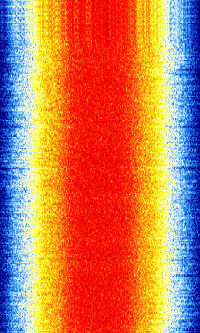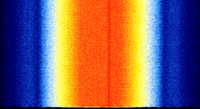Project 25 (P25)
 | |
|---|---|
| Frequencies | 136 MHz,174 MHz,380 MHz,512 MHz,769 MHz,824 MHz,851 MHz,859 MHz,896 MHz,939 MHz |
| Frequency Range | 136 MHz - 939 MHz |
| Mode | NFM |
| Modulation | PSK,C4FM,TDMA |
| ACF | — |
| Emission Designator | — |
| Bandwidth | 12.5 kHz |
| Location | Worldwide |
| Short Description | Project 25 (P25 or APCO-25) is a trunked radio standard developed by The Association of Public Safety Communications Officials International (APCO-25) for use with public safety organizations around the world. |
| I/Q Raw Recording | Download file |
| Audio Sample | |
Not to be confused with Yaesu C4FM
Project 25 (P25 or APCO-25) is a trunked radio standard developed by The Association of Public Safety Communications Officials International (APCO-25) for use with public safety organizations around the world. P25 supports encrypted voice.
Modulations[edit]
Phase I FDMAFrequency Division Multiple Access[edit]
Phase 1 uses a 9600bps data rate to transfer IMBE-encoded voice or packet data. Phase 1 can use either C4FMContinuous 4-Level Frequency Modulation (continuous 4-level FMFrequency Modulation) or CQPSKContinuous Quadrature Phase-Shift Keying (Compatible Quadrature Phase-Shift Keying, also known as LSM, or Linear Simulcast Modulation) modulations. Both uses a 4800bd symbol rate with four-level signaling, resulting in the 9600bps data rate. CQPSKContinuous Quadrature Phase-Shift Keying modulation is more resistant to inter-symbol interference than C4FMContinuous 4-Level Frequency Modulation, and thus is much easier to transmit in a simulcast configuration. It is labelled "Compatible" because the deviation at symbol time is the same as C4FMContinuous 4-Level Frequency Modulation, so FMFrequency Modulation receivers can still decode it. CQPSKContinuous Quadrature Phase-Shift Keying modulation requires a linear amplifier and thus can only be produced by appropriately equipped fixed equipment, such as repeaters and trunked sites. Subscriber equipment, such as portables and mobiles, will transmit in C4FMContinuous 4-Level Frequency Modulation regardless of whether it is receiving CQPSKContinuous Quadrature Phase-Shift Keying.
A non-standard Motorola modulation, wide-pulse, uses 4FSK4-Level Frequency Shift Keying to occupy a wideband radio channel; wide-pulse is rarely found nowadays due to its spectral inefficiency. It was designed to create a wider eye in the waveform, allowing very large distances between simulcast sites. Trunked wide-pulse is only found in Motorola Type II trunked systems with digital voice, as it is not compliant with APCO's Project 25 standard. Most Motorola conventional repeaters and subscriber equipment can transceive in wide-pulse.
Motorola X2-TDMATime Division Multiple Access[edit]
X2-TDMATime Division Multiple Access is a non-standard variation of P25 that Motorola used on some units to implement TDMATime Division Multiple Access before the Phase 2 standard was completed. X2-TDMATime Division Multiple Access uses the same 9600bps bit rate as Phase 1, but uses the two timeslots and AMBE+2 vocoder of Phase 2. Like Phase 2, it was only found on trunked systems. X2-TDMATime Division Multiple Access is no longer supported and virtually all operational equipment has been upgraded to standards-compliant Phase 2.
Phase 2 TDMATime Division Multiple Access[edit]
The Phase 2 standard is a 2-slot, 12000bps TDMATime Division Multiple Access signal that fits inside a 12.5 kHzKiloHertz (kHz) 10^3 Hz wide channel. Fixed site output modulation is H-DQPSKDifferential Quadrature Phase-Shift Keying with subscriber units using H-CPM (Harmonized Continuous Phase Modulation) on the input. This allows existing 12.5 kHzKiloHertz (kHz) 10^3 Hz wide license holders to double call capacity by upgrading their infrastructure to Phase 2. The Phase 2 standard was approved in November 2010, and as of August 2011 Motorola has begun shipping Phase 2 systems. Phase 2 operation is only supported on trunked systems, and conventional operation still uses Phase 1. Additionally, Phase 2 capability applies to the voice channels, and control channels are sent with the same C4FMContinuous 4-Level Frequency Modulation or CQPSKContinuous Quadrature Phase-Shift Keying modulation seen in Phase 1 systems.
Motorola ASTRO 25 systems can also have an optional feature known as Dynamic Dual Mode (DDM), which will seamlessly revert a talkgroup to FDMAFrequency Division Multiple Access operating mode if a Phase I only capable radio affiliates with a Phase II capable talkgroup.
Very recently, some Harris systems began to implement TDMATime Division Multiple Access control channels.
System IDs and NACs[edit]
Project 25 signals carry a three-digit hexadecimal Network Access Code, or NAC. NACs are used similar to CTCSS or DCS on an analog signal, and are used to ensure a radio is receiving the correct signal. Each P25 site, be it a trunked site or a conventional repeater, will use one NAC. The $ symbol before a number represents a hexadecimal value. A few NACs are special:
- $293: The default NAC used on P25 equipment. This NAC is commonly found on interoperability channels and ham radio equipment.
- $F7E: A receiver configured to receive $F7E will ignore the received NAC and always unmute.
- $F7F: A repeater configured to repeat $F7F will retransmit any received NAC intact. For example, it will send NAC $487 if NAC $487 is received, and NAC $293 if $293 is received.
Talkgroup IDs are logical channels used to subdivide traffic on each site. If two groups want to share a single P25 system and not hear each other, they can configure separate talkgroups. Talkgroup IDs are four-digit hexadecimal numbers, but are usually written as the decimal equivalent. Talkgroup 1 ($1) is the default value used (and sent by equipment not configured to use talkgroups), and 65535 ($FFFF) is used as an all-call.
Trunked systems carry an additional set of IDs, called the WACN, System ID, RFSS, and Site ID. The WACN and System ID identify the trunked system, while the RFSS and Site ID identify the trunked site. The WACN and System ID are (intended to be) unique across all trunked systems, while the RFSS and Site ID must be unique only within a trunked system.
- WACN (Wide Area Communications Network) is a 20-bit hexadecimal value used when different trunked systems need to interoperate, and subscriber radios can be configured to roam within other systems with the same WACN. The default WACN is $BEE00.
- System ID is a 12-bit hexadecimal value, together with the WACN, identifies a trunked system. While the default System ID is $001, trunking systems do not use $001 for security reasons. There is no one common value used for System IDs, even in deployable interoperability systems.
- RFSS (RFRadio Frequency Sub-System) is a one-byte hexadecimal (though commonly expressed as decimal) value which identifies a cluster of sites intended to carry the same set of users. Subscriber radios can be configured to roam seamlessly between sites within the same RFSS. The default RFSS is 1 ($1).
- Site ID is a one-byte hexadecimal (though commonly expressed as decimal) value that identifies a single trunked site. The combination of RFSS and Site ID uniquely identify a trunked site within a trunked system. The default Site ID is 1 ($1).
On a trunked system, NACs are not used for transmission identification. Instead, the NAC is commonly set with the first two digits being the first two digits of the System ID, and the last digit being the last digit of the Site ID.
Audio Samples[edit]
| Conventional Voice | Encrypted Voice | Data Channel | Trunking Control Channel |
|---|---|---|---|
| File:P25-C4FM-VC IF.wav | File:P25-C4FM-VC AF.wav | File:APCO25 P1 Data C4FM Audio.mp3 | File:P25 C4FM-CC BEE0014C IF.wav |
| Trunked Voice | Trunking Control Channel |
|---|---|
| File:P25 CQPSK-VC 91FE5105 IF.wav | File:P25 CQPSK-CC 920650D5 IF.wav |
| Conventional Voice |
|---|
| File:P25 WIDE-VC IF.wav |
| Trunked Voice | Encrypted Voice |
|---|---|
| File:APCO25P2voice.mp3 | File:Phase2vicpol.mp3 |
Additional Samples[edit]
P25 Phase 1 Trunking Control Channel: File:P25 trunking channel.mp3
P25 Phase 1 Encrypted Voice Bursts: File:P25 Sound.mp3
P25 Phase 2 Slow Associated Control Channel (SACCH): File:SACCH.mp3
P25 Phase 1 Demodulated Encrypted Audio: File:P25 Phase 1 Demodulated Encryption (Unknown Algorithm).mp3
Frequencies[edit]
Usually found in 138-174 MHzMegaHertz (MHz) 10^6 Hz, 380-512 MHzMegaHertz (MHz) 10^6 Hz, 769-824 MHzMegaHertz (MHz) 10^6 Hz, 851-869 MHzMegaHertz (MHz) 10^6 Hz and 896-939 MHzMegaHertz (MHz) 10^6 Hz frequency ranges.
Emission Designators[edit]
The appearance of one of these emission designators on a license indicates one of these P25 modes may be in use. Different manufacturers may provide different emission designators for the same signal class. Bolded listings are the most common.
- P25 Phase 1, C4FMContinuous 4-Level Frequency Modulation: 8K10F1E, 8K10F1D, 8K10F1W
- P25 Phase 1, CQPSKContinuous Quadrature Phase-Shift Keying: 8K70D1W, 9K70F1D, 9K70F1E, 5K76G1E (erroneous)
- P25 Phase 2, H-CPM: 8K10F7W, 8K10F1W, 8K10F1D, 8K10F1E
- P25 Phase 2, H-DQPSKDifferential Quadrature Phase-Shift Keying: 9K80D7W
- Motorola Wide-Pulse: 20K0F1E
IQQuadrature signals form the basis of complex RF signal modulation and demodulation, both in hardware and in software, as well as in complex signal analysis. Samples[edit]
Decoding Tutorials[edit]
Decoding Software[edit]
- Hobby Level Software
- DSD+. Recommended. Fastlane needed for trunking, phase 2, or reliable CQPSKContinuous Quadrature Phase-Shift Keying operation.
- SDRTrunk
- Trunk Recorder (uses OP25).
- OP25.
- Unitrunker.
- Digital Speech Decoder (DSD).
- DSD-FME (Digital Speech Decoder Florida Man Edition)
- Simple APCO Plugin (For SDR#).
- Professional Software
Video Examples[edit]
- RTL-SDR: Decoding P25 Phase I QPSK with DSD and SDR#
- Decoding P25 with SDR#, DSD, and RTLSDR #2
- P25 Decoding with SDR# and DSD











